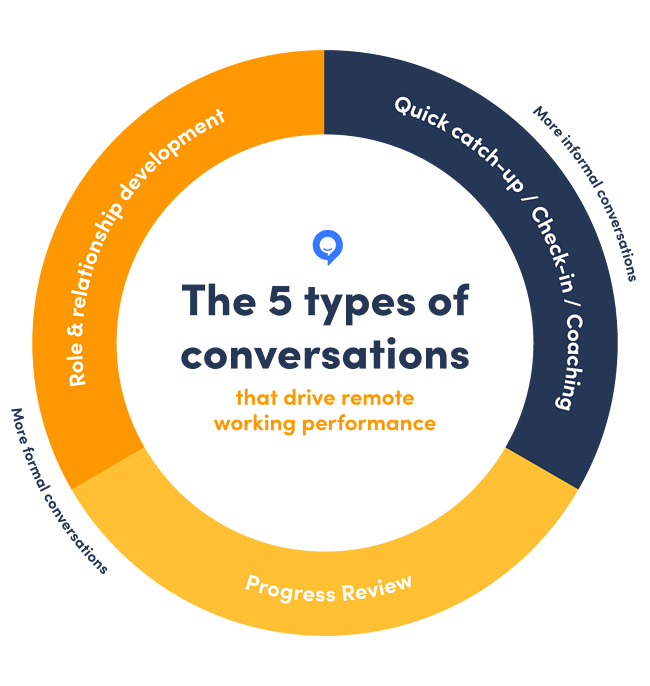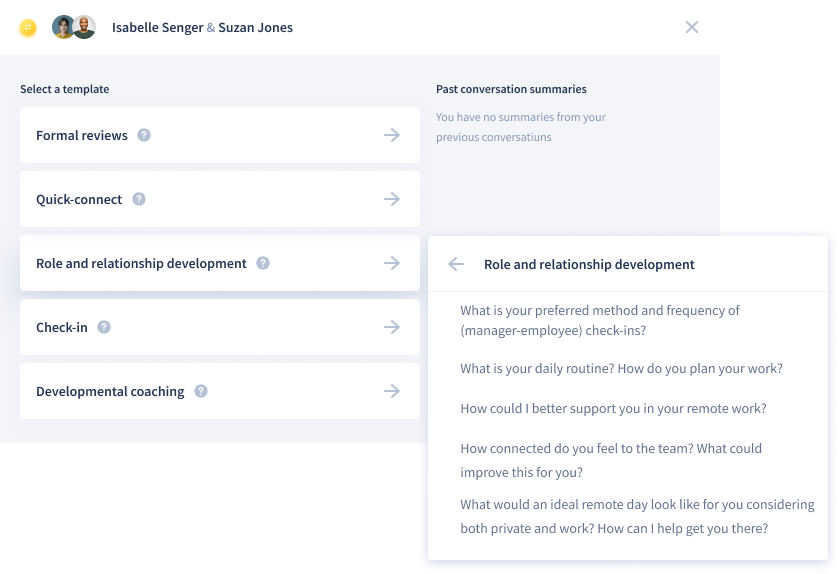
No more coffee chat: The 5 conversations you should have with your remote team
We find ourselves in a unique situation where millions of people are forced to work remotely from one day to another, and managers have not had the time to adapt properly.
Supporting the unique needs of remote workers may seem like a lot of work for a manager, and it definitely can be. Staying on top of the psychological welfare and work environments of remote employees takes time and concern. We find ourselves in a unique situation where millions of people are forced to work remotely from one day to another, and managers have not had the time to adapt properly. In this blog post, we want to help you ramp up your skills necessary to effectively lead a remote team.
No more coffee chat
Suddenly, a large percentage of communication in teams dies. No more talks in the hallway walking from one meeting to the next, no more huddled chats over the coffee machine, no more quick walks around the block to stretch the legs.
To make up for this lack of direct communication one-on-ones between line managers and their teams should happen more often. However, there are rules to the game. Just increasing the volume and frequency of conversations won’t cut it, the goal is not to massively increase the time spent on one-on-ones and cram your agenda full of internal meetings. Three important points to keep in mind are:
- Individualise - The best managers have always individualised their coaching to the worker, but doing so at a distance requires greater intentionality. Managers need to ask each team member to describe the conditions under which they perform best, their concerns about their workflow and their emotional response to the situation.
- Set expectations - Set expectations early and clearly. Many employees (remote or not) don't know what's expected of them at work. That's a bad beginning, and it'll get worse for employees sent home without good guidance. So managers must make expectations crystal clear: X is the work you should do, Y is the quality standard, Z is the deadline. Executives should provide higher-level expectations aligned with the company's purpose: We'll keep our customers engaged by doing X, we'll maintain our standards by doing Y, we'll fulfil our mission by doing Z. The more detail, the better.
- Socialise - Although meetings shouldn’t go on for hours and hours, it's OK to pad socialising into the timeframe. It may even be vital for people who need lots of interaction to keep their energy up. On top of that, your staff also needs to hear from you, especially as economic fears worsen, to maintain their trust in leadership. Keep the lines of communication open, honest and broad.
Now let’s dive into the specifics of what type of 1on1s you should be having
Five Remote conversations templates
Research backed by Gallup has shown that five basic conversations are advised in a remote working situation:

- Role and relationship – This occurs when employees join the company, when job responsibilities shift and when employees change roles and responsibilities. Very relevant in setting expectations during your remote work effort.
- Formal review – Formal reviews of progress on goals, expectations, and planning for future opportunities. This is where your more structured performance appraisal process takes place. Be mindful to adapt your structure to the current reality of day to day work.
- Quick connects – Give managers an opportunity to assess quickly how an employee is doing and to identify successes and barriers.
- Check-ins – More formal opportunities to seek and give feedback on goal achievement, priorities, progress on projects and employee needs.
- Developmental Coaching – Aims to direct and guide an employee to improved performance and individual career development.
The Role and Relationship Development and Formal/Progress Review are two more formal conversations that should be fairly similar to a regular Performance review or Project review. Quick-Connect, Check-in and Developmental Coaching, on the other hand, are more informal and ad-hoc. These are the kinds of conversations you should really increase in frequency, but don’t forget about the rules defined above!
With Unit4 Talent Management, it’s easy as ABC to incorporate these conversations in your performance management platform. Below you can see a quick screenshot of how this could look in the platform:

We’ve distributed these conversations further into 3 subtopics:
- Performance: “How do you do your best work?”
- Personal: “How do you feel at work?”
- Functional: “What do you need from us to do your best work?”
They’re purposefully direct, should help you assess the state of your organisation and filter out the most pressing issues that need to be addressed.
Linking back these questions to the different kinds of conversation, you can use a simple table to see which questions could be used for certain types of conversations.
Performance will most likely be used during role & relationship conversations, Personal should come up during the quick-connects and Functional during the Check-ins.
However, the combination of conversations and questions is only a gentle advice, feel free to mix & match and make it your own!
Conclusion: have a digital coffee
To account for the sudden drop in the flow of communication within teams due to remote working, it’s a line manager’s job to substitute hallway talks and coffee chats with 1on1 conversations. We proposed 5 different types of conversations, each with their own focus on three different conversation topics. Distribute this framework to your line management population and get chatty!





